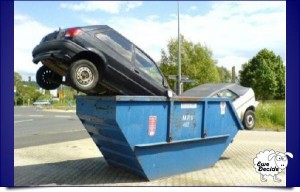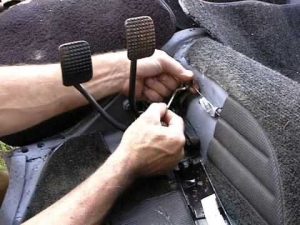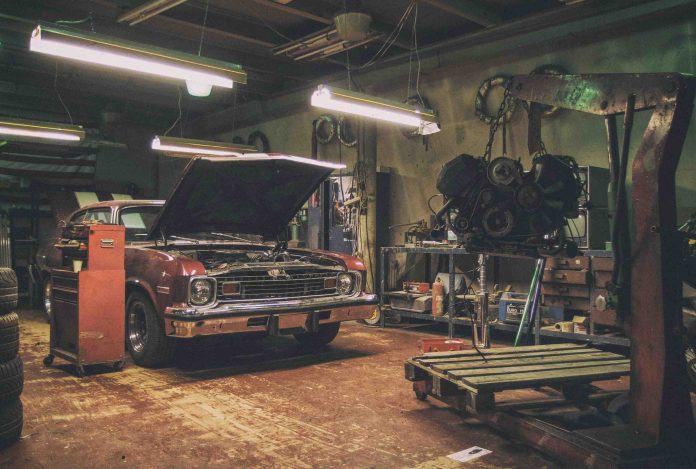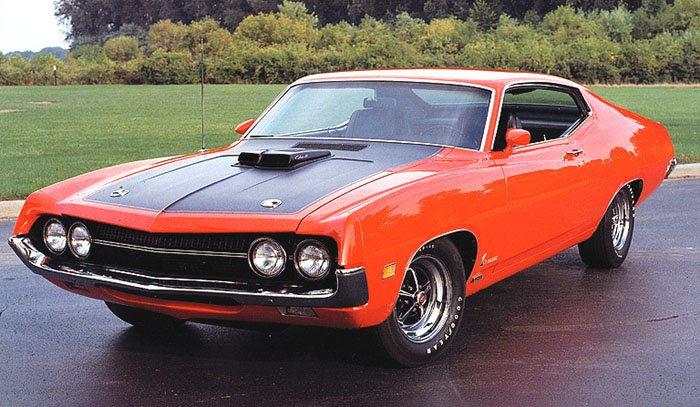Old cars – those made when cars were still mostly mechanical things – would sometimes just stop working. Just as modern, electronically encrusted cars sometimes also stop working. The difference is that when an old car stops working, you have the consolation of (usually) being able to get it working again.
Emphasis on you.
This is an attribute that may become important in the future, when other things stop working. Supply chains, for instance. You may not be able to get the electronic component you need to replace in order to get your modern car working. And there’s no working-around-that, when it comes to modern, electronic cars.
If – as an example – the computer that controls the electronic fuel injection system croaks, which it eventually (inevitably) will, the fuel injection won’t work – and the engine won’t run. Short of major work – as in, replacing the entire fuel delivery system with a mechanical system that does not need a computer to work – the car will never run again. This will be so if you cannot get any of the many electronic peripheral parts without which an modern EFI system won’t work.
It is unlikely in the extreme that you’d be able to get it running by the side of the road. You’d likely have to have it towed – to a shop. Which works – assuming the shop can get the parts needed to get the car to run again.
But when there necessary parts aren’t available, even the best shop can’t do much.
Keep in mind – because it is important to keep it in mind – that electronic car parts are (generally) not repairable. They are replaceable.
It’s a very important distinction.
An old, non-electronically controlled car that has a carburetor – the mechanical fuel delivery system supplanted by electronic fuel injection beginning in the mid-1980s – can be repaired.
Let that percolate a moment.
Whatever’s not working can usually be made to work. The carburetor might only need to be cleaned or adjusted and – once that’s done – it will work like new again. It might need some replacement parts to make it work, but these are not electronic and so it is possible – in a pinch – to make what’s on hand work. Gaskets, for example. These can be cut out of generic cork sheets – or made, using tube sealant. It’ll work is the point. Other parts can – literally – be used, too. As in whatever you have on hand or can scrounge. You do not have to have the exact-fit part because a part that’s close enough can often be made to work.
As in, by the side of the road.
And – here’s the really beautiful thing about mechanical things: You can usually get them to work enough to get you where you need to be. As an example – and there are many – if you have an older car that still has a cable connecting the accelerator pedal to the engine’s throttle arm (which controls the revving of the engine) and that cable snaps (as they sometimes would) you are not necessarily stuck. You will have to stop by the side of the road – because the engine will return to idle and no matter how much you push on the accelerator, the engine won’t respond – if the cable isn’t connected.
But the thing is, you can reconnect it. Maybe with a string. Maybe by just reconnecting it where it snapped. The point is, there are ways to gimp it back together by the side of the road, enabling you to get back on the road.
On the other hand, if the car is newer and has drive-by-wire throttle and the electronics that control the engine glitch or fritz, you aren’t getting back on the road – without getting another ride – because there is no way to gimp-fix electronic parts once they fail. They work – or they don’t. And when they don’t, they don’t.
And that’s it.
Here’s another for-instance: Almost any carburetor can be made to work on almost any carbureted engine. It might not work well. But the point is, it’ll probably work. And it’s not just carburetors, either. With the old stuff, parts can be swapped – including parts from other makes.
So long as you can make them fit.
These are but two examples meant to highlight some general truths that may become much more important truths if other things – such as the economy, itself – stop working. Or, for that matter, the Internet.
If a time comes when you can no longer count on eBay to find a part your car needs to keep it running – and you can’t find one at your local auto parts store, either – you may still be able to make it work with whatever you’ve got on hand (or can get your hands on). The Cubans did this for half a century, keeping cars made in the ’40s and ’50s working well into the 2000s. They may not have looked new; they may not have worked quite like they did when they were new. But the take-home point is they were still working.
And that kept the Cubans going during the Castro years.
We may need to do the same in the coming years.
. . .
If you like what you’ve found here please consider supporting EPautos.
We depend on you to keep the wheels turning!
Our donate button is here.
If you prefer not to use PayPal, our mailing address is:
EPautos
721 Hummingbird Lane SE
Copper Hill, VA 24079
PS: Get an EPautos magnet or sticker or coaster in return for a $20 or more one-time donation or a $10 or more monthly recurring donation. (Please be sure to tell us you want a magnet or sticker or coaster – and also, provide an address, so we know where to mail the thing!)
If you like items like the Keeeeeeev T shirt pictured below, you can find that and more at the EPautos store!












OT: electric car racing?
Nashville grew around the Fairgrounds and the speeedway. Not other way around. Ditto Myrtle Beach Speedway which was shuttered & sold to developers a while back. Newsflash: If you don’t like loud engines, don’t build a house next to a motor speedway. The carpetbaggers & complainers are perfectly fine with the mind-numbing vuvuzelas at their near empty soccer stadium, tho.
https://www.jayski.com/2023/11/22/new-development-proposed-for-nashville-fairgrounds-speedway/
As EP has stated numerous times, cars are appliances that are just thrown away. Do yall remember the era of the TV repairman? Nowadays it’s cheaper / easier to just get a new one (albeit made in Chyyyyna with slave labor). Cars are much the same way –except the “cheaper” part.
This is happening even now. On my 2005 Honda ST1300 the FI light started coming on. The fix in many cases is a new ECU which is no longer available for 2003 – 2007 model years. Fortunately the bike still runs mostly normally. It goes into a default mode where it’s not receiving input from the sensors. The biggest thing I notice is a reduction in fuel economy of 2 – 3 mpg. Some have put many miles on their bikes in this condition. Others swear you shouldn’t ride it until you fix it. I’m in the process of ruling out other causes and may have to take my chances with one off of eBay.
Robbie, see if there is a way to read ‘codes’ if they exist in ’05, not sure.
Even a 2012 dirtbike I had, gave me a FI light, and on the tiny screen I was able to find the ‘codes’, and it told me ‘no temp input’. so i had an ah-ha moment that I had unplugged a few things to waterproof them, and after a little search, sure enough I just bent over a connection tab by mistake.
Chris, thanks for the reply. I read the code and it’s a knock sensor code which is common on these bikes. Thankfully there are experts on an online forum (st-owners.com) to help me figure it out.
I guess a knock sensor default may make the puter go into default mode?
Best of luck.
I have never seen a bike ECU fail. opps not true, an Italian dirtbike a friend owns had one die with 5 miles on it. Only one I’ve ever seen in 30 yrs (that I can remember!) But in the end (2 failed) I troubleshooted that it was fried externally by a bad voltage regulator which cooked it. So not really the ECU’s fault.
Check connectors for corrosion or a pin that’s not making contact. Verify ground paths are good. I had a charging failure on a 04 Harley, the connector between the stator and the rectifier / regulator had a weak pin. I gently moved the socket side parts back with an oring pick and it cured the problem. Worked with a guy that was the crew chief for F4s on the Big “E”, biggest problem was electrical connectors.
It didn’t have to be this way. The electronics that run engines are pretty simple devices. Hall effect sensors, solenoids, SCRs, MOSFET chips, PLCs… All of that stuff is easily set up and programmable by a journeyman programmer. Sure, that particular MOSFET might not be manufactured anymore, but I’ll bet there are ten others that will work just the same. Thing is, it isn’t easy to shoehorn onto a circuit board that’s in a box full of potting compound. And not having any access to the source code means mechanics are dealing with black boxes and factory troubleshooting computers.
If the powers in charge really do what they say and eliminate ICEs people will come up with alternatives, open sourced hardware and software that won’t have all the lockdowns and probably won’t give a rat’s ass about emissions edicts. My guess is it will come from India or South America. But it will take a lot of retrofitting and probably new wiring harnesses. And of course be illegal in the first world countries.
Im guessing the same and we will get the hardware. The next question is that about the bullshit accessories? You have to figure out how the locks and windows work and you could get a generic PLC to operate the cars basic systems. Defrosters, mirrors, locks, windows. and maybe climate control. Panels can be fabricated. I don’t know. Just a guess.
This has been my thought for some time. Ripe with possibilities for a brute force replacement of the factory stuff. There are complete kits for EFI replacement on older carb cars. Some enterprising engineers/ manufacturers should jump in with a box’a’parts to get an ‘obsoleted by electronics’ rig back on the road. Like you say, at the end of the wiring is a window motor, a door lock solenoid, HVAC actuators. Switches and knobs and an electronics package with either full up wiring replacement or adapter cables. Lose the “opera lighting” but avoid 50k for a new car is fine with me.
All the pieces ar available now, Megasquirt engine management and various transmission controllers, Arduino for various body control functions, stability control, antilock brakes, etc. The problem is that it’s all proprietary, there are no real standards, and it takes a LOT of time=money to do it.
And modern cars are simply not worth the effort because they are optimized designs with lots of rusting metal, deteriorating plastic, and “just barely heavy enough to last” parts all failing at a similar rate. Those of us that do resto-mods do all of those things. EFI/ engine management? Climate control? Modern multiple overdrive transmissions? Stability control? Check, check, check on them all.
But by the time I do a really nice 50 Ford, or 49 Buick, or 56 Chevy into a nice, quality car with all the good and useful modern technology, I have to sell it for 150k to make it worth my while.
There is a market for it, but it’s limited. Until quality returns to manufacture and control returns to the customer, free and independent travel are over in this country.
Hey ReadyK,
I agree. A few years back, the MAP sensor quit on my S10, and I couldn’t find one that worked, even a used one from eBay. They demonstrably wouldn’t work, by the way, as in I rigged them up and pulled vacuum on them, and the signal voltage wouldn’t change.
I made my first replacement by cobbling together a device using the diaphragm from a fish aquarium aerator, an adjustable screw, magnet and hall effect sensor. It worked, though not perfectly.
I eventually replaced it with a commercially available pressure sensor. This DID seem to work perfectly, though it wouldn’t pass emissions any longer, so I just registered it under my rural address (before finally moving here).
There’s a kit you can buy for about $800 to delete the EFI on a new harley and replace it with a carb and throttle cable. Really clears the plastic computer junk up at the front of the bike, and runs cooler too.
Tales from the road you probably cant do in a modern car or motorcycle:
-Had a throttle cable break a few miles from home- turned the idle screw up to the max and fast idled home on a CB750
-Had a clutch cable break on a harley- rev matched shifted home from a county away
-broke a transfer case yoke 500 miles from home in an old 4×4- pulled the rear drive shaft and drove home on the front axle all under 55mph
-burned out a transmission 1000 miles from home- drained and replaced as much fluid as possible, and got it going all the way home slipping after stops, but it was mostly highway
just a few examples
A rock jumped up from a tire throw and knocked a small hole in a brake line. Next stop sign, all of the brake fluid emptied out of the brake line breech. 100 miles from home, bummer.
You then know what your emergency brake is for.
You make it back home, you don’t want anything else to go wrong.
Why does this happen to me? You’re gimped at that point.
Hi Drump,
Modern cars have a dual-reservoir system for just this reason. If the front brake circuit develops a leak, the rear brakes ought to still have hydraulic pressure and work. The ’64 Corvair I used to own had a single reservoir master cylinder and if any of the lines leaked, you had no hydraulic brakes. But you still had a way to slow/stop the car, via the mechanically controlled emergency brake. This has been effectively eliminated from almost all modern cars via an electrically controlled parking brake that’s either On or Off. You can’t modulate the brake force pressure to slow the car in a controlled manner.
Saaaaaaaaaaaaaaaaaaafety first!
Lost a caliper bolt on the front RH, 05 Grand Cherokee, made it home via the Hand Lever Emergency Brake that is now considered obsolete.
Eric, it happened a long time ago now, going on 40 years. It was a 1963 Ford 4-door. Sure do miss the car these days, can’t remember how it got away.
I did a fix with an inline fitting that worked okay.
Brake lines have pressures of 9000 pounds, so I’ve read. Had a brake line leak on the Ford truck that had to be fixed. Front and back brakes, dual reservoir systems have to be.
Old, emergency brake. Hydraulic systems do occasionally fail.
New, parking brake, which in most cases the park position on your AT will take care of.
Way back when I was a sprite and dinosaurs still roamed the earth, I had the acquaintance of an old hippy who had meandered across Africa in a VW Combi (hippy van camper). He told me of breaking his last fan belt in the middle of the desert. His solution? A pair of pantyhose, source unclear and not explicitly mentioned, was twisted and knotted and pressed into service, allowing his generator to keep charging and his air cooling fan to keep working, for about 100 miles.
That story inspired me, to this day I look for stuff well designed and reliable enough to always make it home.
Unfortunately the well designed, simple, reliable stuff has not been made since the 1950’s with a few notable exceptions.
Hi Ernie,
VW sold new (old) Beetles in Mexico until 2000 or so; there are millions of old Bugs still out there and they are as easy to keep going as a Briggs and Stratton lawn mower engine. Most cars made through the late 1970s are similar. A car like my old Trans-Am can be kept running almost indefinitely.
My 79 Gran Prix had a sensible HVAC design. Instead of buried inside the dash, the heater core and a/c coil were in a box with a removable lid accessible from the engine compartment. In 21 years of ownership the heater core got replaced twice, while open I cleaned the fir needles out of the bottom and made sure the condescent drain was clear for the a/c. Western WA = fir needle city, doesn’t matter where you live over there the G damn needles are everywhere.
Hi Sparkey,
You also have a ’79 GP? That is excellent, sir! I love the mid-sized personal coupes of that era. They are everything a same-era Firebird is, with viable back seats and a nice big trunk. Wonderful roads cars. I had a friend who owned a ’71 GP with the 455. It was a Hurst Edition, white and gold color scheme. Came with a factory TV, too!
Oh baby ‘71 G P with that aircraft carrier size hood!
I bought my ‘79 used in ‘84. The ‘84 edition of the old biddies pearl clutcher consumer magazine listed it as a “don’t buy” in their used car section. The trans was rebuilt before I bought it, that Turbo 200 was the weak link but rebuilt with upgraded parts was fine. Bought it with 65k miles, drove it to 355k in 21 years with normal maintenance. 301 V8 smooth as silk. Trans finally puked, trunk and rear deck lid rusting out, a/c quit around that time. Sorry Old Yeller, you had a great run!
If you swap an ECU the new one may not work because of the VIN mismatch. You would have to call the manufacturer and download the program for your car IF they still have it. Costs are very high.
Indeed, if you replace a headlight or the factory radio the whole thing may shut down. To protect you from theft, you know….
Points failed on my 68 Chevy half ton. Repaired on the roadside with my wife’s finger nail file.
I have several new points and ballast resisters in my glove box at all times when driving my old Charger!
Part of what allows the Cubans to keep those old cars running is that they are RWD. Just try to swap in an engine out of a Skoda tractor into a FWD car and you’ll see it’s a lot harder. On the RWD car the hardest part would be adapting the tranny to fit. Drive shaft, electrical and engine mounts would be relatively easy in comparison. If you started with a car or truck engine/ tranny you’re more than half way there.
Poor people are more likely to have those skills because they can’t afford to higher skilled people. Of my friends most don’t change there own oil any more but most of them are still doing some repairs at least.
This article highlights the reason I am a looking for a sound, doesn’t have to be pretty, 1980s Chevy 1/2 ton with a 350 V8 pickup (square body). Solid frame, no uni-body, body parts were still a heavy gauge of steel, all basic mechanical parts are easy to find and usually cheap. No electronic anything, OK maybe the radio, NO DRIVE BY WIRE or CONNECTIVITY, and all the controls are mechanical or electro-mechanical. You can haul things like a load of firewood, pull a trailer and if it hasn’t been lowered and has stock wheels and quality tires it can handle primitive roads that would scare most modern Jeeps. AND you can fix EVERYTHING that goes wrong YOURSELF or you can find a “shade tree” mechanic if you get in over your head. If things go from bad to worse, this is the one vehicle to have.
Hi David: Don’t forget Dodge’s and Ford’s of the same era as they are just as repairable.
check out the M1008 CUCV 5/4 ton square body, you might like it, though its geared down so 55pmh is max speed
Great minds think alike…….. In 18 (way before becoming enlightened here) I bought a Colorado Z71. Pretty much a second vehicle for me so it’s living an easy life. I take really good care of it and it’s only got 29K on it and it’s paid for. I’m hoping the ignorant masses won’t get clued onto the concept of this article for a bout 5 years. So my diabolical plan is before that time to buy an old, clean truck from the west either by using the funds from selling the Colorado or trading it for said “classic” square body! Maybe 2! 😀